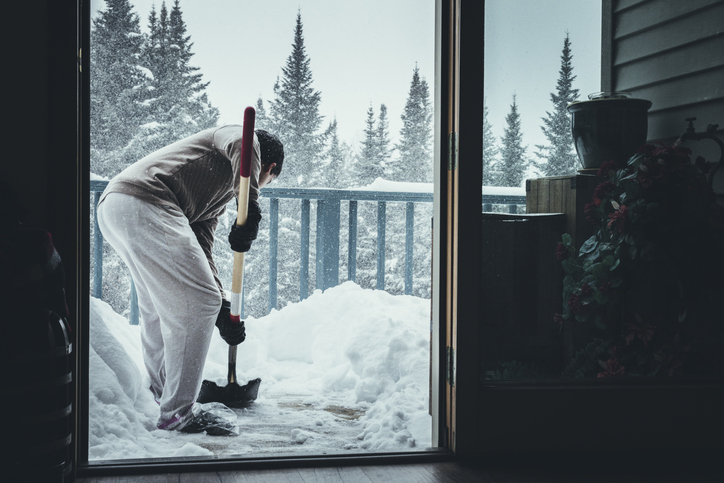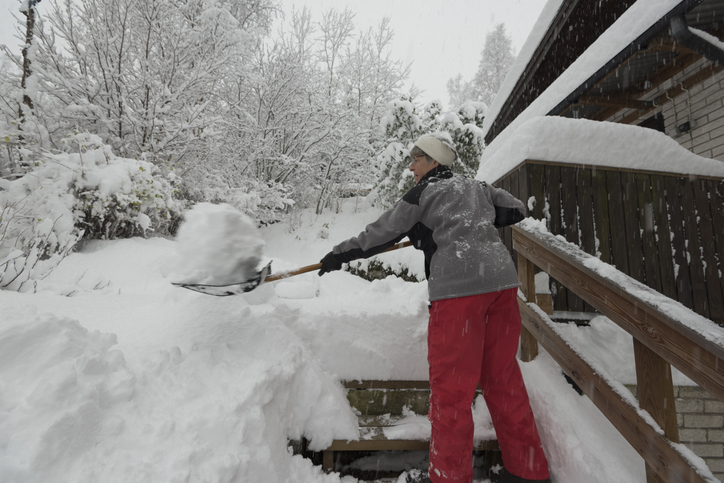How to Effortlessly Protect Your Vinyl Deck This Winter

Temperatures are plummeting this time of year, but you feel reassured because you have a vinyl deck and won’t have to worry about the potential decay that can happen with wood.
Vinyl is manufactured to last temperatures as low as 40-below and won’t crack under the snow’s pressure. What vinyl can’t protect itself against is the shovel you’re using to remove snow or the amount of ice forming below its surface.
Remember, the key this time of year is to preserve your vinyl deck’s appearance so when spring comes it looks as new as the day it was built.
Winterize Your Vinyl Deck
Protect your vinyl deck this winter with these 6 easy steps:
- 1. Rinse your deck after the leaves have fallen
- 2. Only use a plastic shovel for snow removal
- 3. Clear snow from your deck regularly
- 4. Remove icicles from underneath the deck
- 5. Apply salt for traction
- 6. Rinse deck once spring breaks
Let’s break these steps down in more detail to ensure you keep your deck looking fresh for next summer.
1. Rinse Your Deck After the Leaves Have Fallen
A simple way to winterize your vinyl deck is to give it a good rinsing. Vinyl owners know to do this in the spring to clean the leftover soot from the winter, but if you do this step before the snow falls, you can protect your deck’s surface from being stained.
Leaves, twigs and other organic materials tend to collect on your deck as temperatures drop. Wash away these materials with either your hose or a pressure washer so they are properly removed before they become frozen on your deck. The pigment from these materials can wear off and leave a stain in the spring if they aren’t removed.
Temperatures are already below freezing in the northern part of the country. If you are located in this area, take a 24-inch broom and vigorously brush your deck’s surface to remove all organic material. This will go a long way in preserving the color of your vinyl deck.
2. Only Use a Plastic Shovel for Snow Removal
Heavy snowfall is just around the corner, and if you’re like us, your snowblower is already gassed up and ready. You probably have a metal shovel in your garage for the snow around your porch as well.
Don’t, under any circumstances, use that metal shovel on your deck.
The metal will scratch the vinyl and leave cut marks all over your deck. Buy a plastic shovel to remove the snow from your vinyl deck correctly.

3. Clear Snow From Your Deck Regularly
Vinyl is the strongest material you can use for decking. It’s manufactured to bend under excessive pressure and withstand that wet, heavy snow that falls just before springtime.
However, if you want to keep your deck looking new next summer, snow removal on your vinyl deck is vital.
You want to avoid snow drifts from forming on your deck. It’s hard to stop the wind from pushing snow to one side of your deck, but if there’s a mound of snow leaning on your deck’s railing, it could cause it to bend. Play it safe — grab your plastic shovel and remove the snow.
4. Remove Icicles From Underneath the Deck
Icicles can form on the sides and underneath your deck just as easily as they form from the roof of your home. This ice can be dangerous for several reasons.
- Because the base of your deck tends to be lower than your roof, the icicles are closer to what’s underneath. This could be your children or pets playing in the snow.
- If the icicles become too big, they can also chip the surface of your vinyl, making your deck look worn and old.
Remove these icicles responsibly and safely.
You can do this the same way you would get them off your roof. Make sure you’re several feet away from the icicle (never below it) and gently push your shovel against the base of the icicle.
5. Apply Salt for Traction
Snow removal on your vinyl deck is a good first step toward its protection. Go the extra mile by applying salt for traction. This will prevent ice from formulating on your deck which can be dangerous for you and harmful for your deck’s surface.
Salt mixed with moisture can rot wood and make it weak. But one of the many advantages of vinyl is that salt won’t harm the material at all.
Make sure you’re using animal-friendly ice melters to help protect your pet and the wildlife in your area.
6. Rinse Deck Once Spring Breaks
This step goes back to winterizing your vinyl deck. You should always clean your deck when the temperature is consistently staying above freezing.
A quick wash will remove the dirt collected in the leftover snow and ice as well as remove any ice melter chemical or salt your applied over the winter. This step is more cosmetic than anything, but well worth it if you want your deck to shine in the summer.
There you have it — no staining and no painting is needed. Winterizing your vinyl deck is easy and goes a long way toward helping its appearance.
If you’re sick of taking extra steps toward protecting your wood deck, consider building a vinyl deck next spring with the easy-to-install options from Vinyl Fence Wholesaler.
Our Everwood Deck is manufactured to last throughout long, cold winters. Our decks also come with a manufacturer’s lifetime warranty so you never have to replace your deck. Contact our team to receive a quote and never worry about your wood decking cracking in sub-zero temperatures again.


